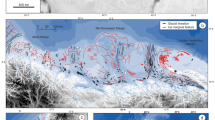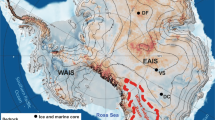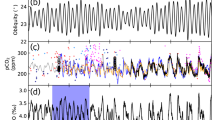Abstract
The onset of major glaciations in the Northern Hemisphere about 2.7 million years ago1 was most probably induced by climate cooling during the late Pliocene epoch2,3. These glaciations, during which the Northern Hemisphere ice sheets successively expanded and retreated, are superimposed on this long-term climate trend, and have been linked to variations in the Earth’s orbital parameters4. One intriguing problem associated with orbitally driven glacial cycles is the transition from 41,000-year to 100,000-year climatic cycles that occurred without an apparent change in insolation forcing5. Several hypotheses have been proposed to explain the transition, both including and excluding ice-sheet dynamics6,7,8,9,10. Difficulties in finding a conclusive answer to this palaeoclimatic problem are related to the lack of sufficiently long records of ice-sheet volume or sea level. Here we use a comprehensive ice-sheet model and a simple ocean-temperature model11 to extract three-million-year mutually consistent records of surface air temperature, ice volume and sea level from marine benthic oxygen isotopes12. Although these records and their relative phasings are subject to considerable uncertainty owing to limited availability of palaeoclimate constraints, the results suggest that the gradual emergence of the 100,000-year cycles can be attributed to the increased ability of the merged North American ice sheets to survive insolation maxima and reach continental-scale size. The oversized, wet-based ice sheet probably responded to the subsequent insolation maximum by rapid thinning through increased basal-sliding13,14, thereby initiating a glacial termination. Based on our assessment of the temporal changes in air temperature and ice volume during individual glacials, we demonstrate the importance of ice dynamics and ice–climate interactions in establishing the 100,000-year glacial cycles, with enhanced North American ice-sheet growth and the subsequent merging of the ice sheets being key elements.
This is a preview of subscription content, access via your institution
Access options
Subscribe to this journal
Receive 51 print issues and online access
$199.00 per year
only $3.90 per issue
Buy this article
- Purchase on Springer Link
- Instant access to full article PDF
Prices may be subject to local taxes which are calculated during checkout



Similar content being viewed by others
References
Raymo, M. E. The initiation of Northern Hemisphere glaciation. Annu. Rev. Earth Planet. Sci. 22, 353–383 (1994)
Lear, C. H., Elderffield, H. & Wilson, P. A. Cenozoic deep-sea temperatures and global ice volumes from Mg/Ca in benthic foraminiferal calcite. Science 287, 269–272 (2000)
Lawrence, K. T., Zhonghui, L. & Herbert, T. D. Evolution of the eastern tropical Pacific through Plio-Pleistocene glaciation. Science 312, 79–83 (2006)
Hays, J. D., Imbrie, J. & Shackleton, N. J. Variation in the Earth’s orbit: Pacemaker of the ice ages. Science 194, 1121–1132 (1976)
Clark, P. U. et al. The middle Pleistocene transition: Characteristics, mechanisms, and implication for long-term changes in atmospheric pCO2 . Quat. Sci. Rev. 25, 3150–3184 (2006)
Berger, A., Li, X. S. & Loutre, M. F. Modelling northern hemisphere ice volume over the last 3 Ma. Quat. Sci. Rev. 18, 1–11 (1999)
Clark, P. U. & Pollard, D. Origin of the Middle Pleistocene transition by ice sheet erosion of regolith. Paleoceanography 13, 1–9 (1998)
Tziperman, E. & Gildor, H. On the mid-Pleistocene transition to 100-kyr glacial cycles and the asymmetry between glaciation and deglaciation times. Paleoceanography 18 1001 10.1029/2001PA000627 (2003)
Muller, R. A. & MacDonald, G. J. Glacial cycles and orbital inclination. Nature 377, 107–108 (1995)
Raymo, M. E., Lisiecki, L. E. & Nisancioglu, K. H. Plio-Pleistocene ice volume, Antarctic climate, and the global δ 18O record. Science 313, 492–495 (2006)
Bintanja, R., van de Wal, R. S. W. & Oerlemans, J. Modelled atmospheric temperatures and global sea level over the past million years. Nature 437, 125–128 (2005)
Lisiecki, L. E. & Raymo, M. E. A. Pliocene-Pleistocene stack of 57 globally distributed benthic δ18O records. Paleoceanography 20 10.1029/2004PA001071 (2005)
Clark, P. U., Alley, R. B. & Pollard, D. Northern Hemisphere ice-sheet influences on global climate change. Science 286, 1104–1111 (1999)
Marshall, S. J. & Clark, P. U. Basal temperature evolution of North American ice sheets and implications for the 100-kyr cycle. Geophys. Res. Lett. 29 10.1029/2002GL015192 (2002)
Lisiecki, L. E. & Raymo, M. E. Plio-Pleistocene climate revolution: Trend and transitions in glacial cycles. Quat. Sci. Rev. 26, 56–69 (2007)
Raymo, M. E. & Nisancioglu, K. H. The 41 kyr world: Milankovitch’s other unsolved mystery. Paleoceanography 18 1011 10.1029/2002PA00791 (2003)
Imbrie, J. et al. in Milankovitch and Climate (ed. Berger, A. L.) 269–305 (Reidel, Dordrecht, 1984)
Maslin, M. A., Li, X. S., Loutre, M. F. & Berger, A. The contribution of orbital forcing to the progressive intensification of northern hemisphere glaciation. Quat. Sci. Res. 17, 411–426 (1998)
Ruddiman, W. F. Orbital insolation, ice volume and greenhouse gases. Quat. Sci. Rev. 22, 1597–1629 (2003)
Shackleton, N. J. The 100,000-year ice-age cycle identified and found to lag temperature, carbon dioxide, and orbital eccentricity. Science 289, 1897–1902 (2000)
Maslin, M. A. & Ridgewell, A. J. in Early-Middle Pleistocene Transitions: The Land-Ocean Evidence (eds Head, M. J. & Gibbard, P.L.) 19–34 (GSL Special Publication Vol. 247, Geological Society, London, 2006)
Valdes, P. & Glover, R. W. Modelling the climate response to orbital forcing. Phil. Trans. R. Soc. Lond. A 357, 1873–1890 (1999)
Shackleton, N. J. et al. Oxygen isotope calibration of the onset of ice-rafting and history of glaciation in the North Atlantic region. Nature 307, 620–623 (1984)
Raymo, M. E. The timing of major climate terminations. Paleoceanography 12, 577–585 (1997)
Kawamura, K. et al. Northern Hemisphere forcing of climatic cycles in Antarctica over the past 360,000 years. Nature 448, 912–916 (2007)
Huybers, P. Glacial variability over the last two million years: An extended depth-derived age model, continuous obliquity pacing, and the Pleistocene progression. Quat. Sci. Rev. 26, 37–55 (2007)
Weertman, J. Stability of the junction between an ice sheet and an ice shelf. J. Glaciol. 13, 3–11 (1974)
Parrenin, F. & Paillard, D. Amplitude and phase of glacial cycles from a conceptual model. Earth Planet. Sci. Lett. 214, 243–250 (2003)
Alley, R. B. & Clark, P. U. The deglaciation of the Northern Hemisphere: A global perspective. Annu. Rev. Earth Planet. Sci. 27, 149–182 (1999)
Acknowledgements
Financial support to R.B. was provided by the Netherlands Organisation of Scientific Research (NWO), in the framework of the SPINOZA award of J. Oerlemans, and through the EU programme Quantify. This work was initiated during the start-up phase of the Utrecht Centre for Geosciences (UCG) programme. We thank W. Greuell, D. Lea, L. Lourens, M. Siddall and N. Weber for remarks on earlier versions of the paper.
Author information
Authors and Affiliations
Corresponding author
Supplementary information
Supplementary information
This file contains Supplementary Methods with additional references and Supplementary Figures 1-6 with Legends. In this file, the methods and uncertainty estimate are discussed in more detail. Moreover, a comparison between our reconstructed data and independent paleotemperature records is shown. Finally, the mechanisms associated with the middle Pleistocene transition and the 100-kyr glacial cycles, including the inception and termination phases, are discussed in detail. (PDF 12004 kb)
Supplementary information
This file contains Supplementary Data. (TXT 2061 kb)
Rights and permissions
About this article
Cite this article
Bintanja, R., van de Wal, R. North American ice-sheet dynamics and the onset of 100,000-year glacial cycles. Nature 454, 869–872 (2008). https://doi.org/10.1038/nature07158
Received:
Accepted:
Issue Date:
DOI: https://doi.org/10.1038/nature07158
This article is cited by
-
Long-distance migration and venting of methane from the base of the hydrate stability zone
Nature Geoscience (2024)
-
Geotechnical characterization of the diatomaceous silty soil in Walvis Bay, Namibia: mechanical properties and interpretations of CPTu records
Bulletin of Engineering Geology and the Environment (2024)
-
A gradual change is more likely to have caused the Mid-Pleistocene Transition than an abrupt event
Communications Earth & Environment (2023)
-
The Mid-Pleistocene Transition: a delayed response to an increasing positive feedback?
Climate Dynamics (2023)
-
Increased terrigenous input from North America to the northern Mendeleev Ridge (western Arctic Ocean) since the mid-Brunhes Event
Scientific Reports (2022)
Comments
By submitting a comment you agree to abide by our Terms and Community Guidelines. If you find something abusive or that does not comply with our terms or guidelines please flag it as inappropriate.



